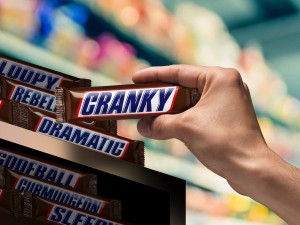Coca-Cola personalized their bottles using the names of their audience in their “Share a Coke” campaign and made tattoo applicators out of their cans for their Latino-targeted “Celebrate Your Heritage” campaign. Snickers added mood indicators (grouchy, sleepy, whiny, etc.) to their packaging and Bud Light wrapped their cans in each NFL team’s logos and colors. Why are more and more companies using an increasingly personalized approach to packaging and branding?
For the consumer, this approach connects them to the brand on an individual level. It gives the brand a humanistic touch and turns the product into a part of life. It connects the product to something we already care about or feel; but why the tide of change now?
What about human behavior makes this approach relevant to today? The answer is in the behavior of sharing.
With the rise of our always-connected, social media-driven culture, consumers are choosing brands not just because of their prices or advertisements, but because those brands contain an aspect of their brand to which the consumer can connect – everything from a familiar logo or name to an emotional tie-in or, as is the case in this situation, the ability to “social media-ize” their purchase.
What is this made-up term and what does it mean for brands? To “social media-ize” a product is when it possesses characteristics that drive consumer actions to share and discuss it online. We’ve all seen the pictures from our Facebook friend of a coke bottle with their name on it, or the Instagram photo of your favorite team’s customized Bud Light can – and that is exactly the type of secondary action these brands want consumers to take.
The first action, of course, is to buy the product. But the search for second-level interaction and sharing is where true brand connections are made. If a consumer connects at a level with a brand to where they make the decision to publicize this connection online, it’s a sign of a developing brand loyalty or brand pride.
This brings us back to the trend of personalize packaging and branding. The main connection is along the lines of why people scream when a musician mentions their city in a concert, or why pictures are taken when you happen upon a road that bears your name – when we see outside objects (or in this case, brands) that we can personally connect with, it reaches a deeper level of care. In the case of personalized brand strategies, this care is a stepping stone to establishing brand loyalty.
Now if you’ll excuse me – I need to go find a Diet Coke can with “Matt” on it.
Image Sources:
https://www.facebook.com/snickers/photos/a.190457414461.156238.20645199461/10153550519214462/?type=3&theater
https://dailymail.com.ng/wp-content/uploads/2015/02/2086086_coke2_jpege59b8a3373855ccb169cfd02e45e9626.jpg
Addison Whitney is a global branding firm with a passion for building strong brands.
To learn more about Addison Whitney, visit our website at AddisonWhitney.com, or contact us here.
